GREECE
Economy

Economy
Cities in GREECE
| Athens |
Popular destinations GREECE
| Aegina | Alonissos | Andros |
| Chios | Corfu | Crete |
| Hydra | Kalymnos | Karpathos |
| Kefalonia | Kos | Lefkas |
| Lesbos | Mykonos | Naxos |
| Paros | Patmos | Peloponnese |
| Poros | Rhodes | Samos |
| Santorini | Skiathos | Skopelos |
| Spetses | Thasos | Zakynthos |
Economy
General
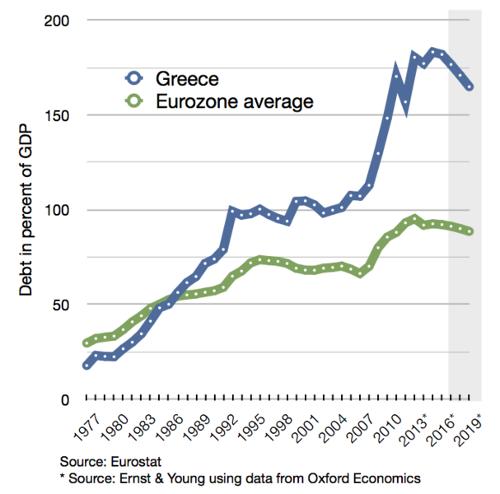 Development of the Greek government debt versus the European averagePhoto: Spitzl CC 3.0 Unported no changes made
Development of the Greek government debt versus the European averagePhoto: Spitzl CC 3.0 Unported no changes made
Greece has been an agricultural country since ancient times, but in the mid-1960s industry and the service sector (tourism!) Became increasingly important. In 1965 even 47% of the working population was employed in agriculture; in 2002 this had dropped to 17%. Nevertheless, this percentage is still very high compared to the other EU countries, where on average only 7% of the population is employed in agriculture. The industry is dominated by small companies, while the large companies are mostly in the hands of the government.
Inflation in the period from 1985 to 1994 was 15.5% on average per year. In 2000 this was 3.1%.
The 1998 budget was dominated by reducing the budget deficit to 3% of gross domestic product. This was one of the conditions to participate in the European Monetary Union. In 1998 it was decided to include the drachma in the European Monetary System and in 2000 Greece formally applied for membership of EMU.
However, the Greek economy remains one of the least developed in the EC and sectors such as computer technology and electronics are still very insignificant. Greece therefore receives large sums from the regional development funds to promote the development and diversification of agriculture in particular. In the interior, the emphasis is on the development of the medium-sized cities (including Patras, Volos and in the north Xanthi, Kavalla and Alexandroupolis). Among other things, this attempts to limit the further growth of Athens.
The ban on establishing more industries in the Attica basin also fits in this context. In industrial development, emphasis is placed on the production of semi-finished products.
In 2004, the Karamanlis government, after taking stock of the Greek economy, adjusted all budgets downwards after 2000. The government has pledged to bring the budget deficit back below the 3% limit in 2006 and to implement structural adjustments. However, the opposite turned out to be true, as at the end of 2009 the full extent of the Greek debt crisis is starting to penetrate. Greece is no longer considered creditworthy because of the excessively high national debt. Papandreou announces substantial cutbacks, which will lead to riots with the population. There is severe action in the public sector and the retirement age is rising sharply. In February 2010, European government leaders pledged to help Greece solve the debt crisis, but on hard terms. A huge amount will be made available in April and May. Greece will have to cut even harder in return for this. The unions are calling for a general strike.
The last few years have been dramatic for the economy growth has been continuously negative. In 2011, 2012 and 2013 it was successively -7.1%, -6.4% and -4.2%. The only positive thing is that the contraction seems to be slowing down a bit. In 2017 the economy will grow again by 1.7% for the first time. Per capita GDP has dropped to $27,800 per year.
Agriculture, livestock, forestry and fishing
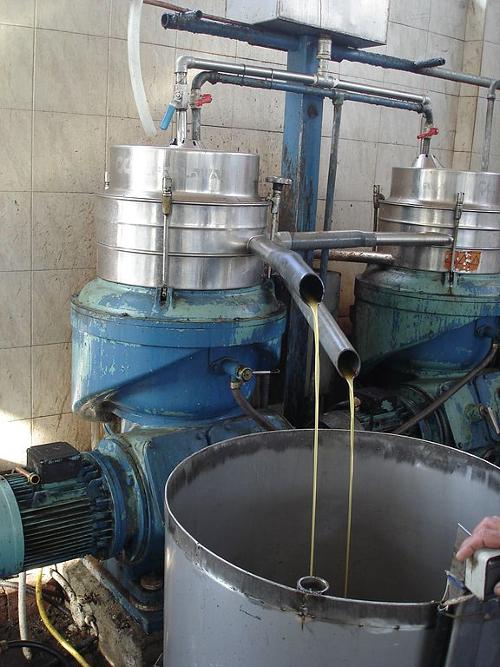 Production of olive oil in GreecePhoto: Rutger22 CC 3.0 Unported no changes made
Production of olive oil in GreecePhoto: Rutger22 CC 3.0 Unported no changes made
No more than 26.5% of the total soil surface of Greece has been cultivated, of which only about 40% is irrigated. Furthermore, 40% of the land is used as pasture land. The major agricultural areas are located in Central and Northern Greece. The farms generally do not exceed 10 hectares and are also spread over fragmented plots. Greece has about 860,000 agricultural holdings with an average farm size of about 3.5 ha. Half of these companies are located in the mountain regions and on the islands. Large land ownership does not occur at all. 60% of the agricultural area is used for arable farming.
Greek agriculture produces mainly for export and the main products are citrus fruits, raisins, currants, cotton, tobacco and olives, which are mainly processed into olive oil. Although the turnover of traditional products is barely growing, Greece is still the largest currant producer in the world. The production of rice (west coast Peloponnese), wheat, sugar beets, tomatoes, cotton and cotton seed is becoming increasingly important. The cereals are mainly grown on the plains of Thessaly, Thrace and Macedonia. The main products of fruit cultivation are: peach, citrus, cherry, apple, pear and grapes. Grapes are grown all over Greece to make wine. Greece is currently the world's largest exporter of canned peaches.
The Greek market for organic food is still in its infancy, but it is expected that this sector will grow in the coming years. Import products currently make up 25% of the market because Greek ecological agriculture and livestock farming receives little support from its own government. The most popular organic agricultural products include olive oil, wine and citrus fruits.
Animal husbandry has only a modest place in the Greek economy. The dry and hot climate and lack of fertile pastures make intensive livestock farming very difficult.
Most of the Greek livestock consists of sheep and goats. There are also many pigs and chickens. It will be clear that beef and milk are completely dependent on imports, and the Netherlands is by far the most important supplier. The Netherlands is facing increasing competition from France, Denmark, Italy and Germany.
Due to the poor quality of the forests, the Greeks are forced to import about 90% of the required wood.
Employment in fishing is gradually declining. The most widespread is inshore fishing and total catches have steadily increased in recent years. Domestic demand for fish is on the rise due to higher incomes and healthy food trends. This has led to an increase in the import of frozen fish in particular.
Sponge fisheries are of decreasing importance due to, among other things, water pollution, overfishing and synthetic products that have largely replaced natural products.
Mining and energy supply
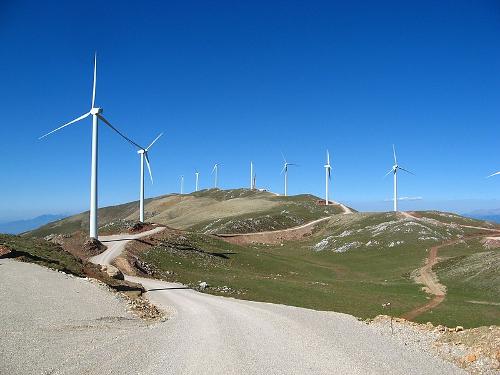 Wind farm GreecePhoto: Kolori at English Wikipedia CC 3.0 Unported no changes made
Wind farm GreecePhoto: Kolori at English Wikipedia CC 3.0 Unported no changes made
Petroleum and natural gas are exploited in the northern part of the Aegean Sea and in South Kavala. Half of the production is exported. More petroleum discoveries are expected in the near future. Lignite is found in Macedonia for use in power plants.
Greek mining is becoming increasingly important in the EU because of the bauxite, nickel, magnesium and uranium, which are not found in other EU countries. Sea salt is extracted along the coasts and on some islands.
The Greek aluminum sector is growing steadily. The products exported mainly concern bauxite and aluminum oxide. Greece ranks eighth in the world for bauxite mining.
Greece is a net importer of energy. Two thirds of the primary energy requirement is covered by imports, mainly of oil. In previous years, Greek energy policy has focused on replacing oil with lignite because this raw material is abundantly present in Greece. However, for environmental reasons, it is not given so much importance anymore. Scenarios indicate that the share of lignite must be significantly reduced in favor of natural gas. In connection with this, it was decided to import natural gas from Russia. A 550-kilometer pipeline has been built for this from the Greek-Bulgarian border.
Algeria is also becoming an important gas supplier and for this purpose a terminal was built on the uninhabited island of Revithoússa in the Saronic Gulf, where the supplied liquid gas is converted into gas again.
Own oil production is low. The oil used to come from the Prinos oil field, which covered about 10 percent of the country's oil needs. In 1999, the consortium stopped operating the oil field because oil supplies were starting to run out. A Greek company took over the operation, but at the end of 2001 production was limited to 4,500 barrels per day. A second, more promising oil field is not being developed due to ongoing conflicts with Turkey over territorial waters and continental shelf rights. Oil supplies also appeared to be present on and off the Ionian coast, but the results of an international survey were not encouraging.
The country has four oil refineries: two private and two state-owned, with a capacity of about 22 million tons per year. More than 60 percent of processed products are sold domestically.
The Greek Ministry of Development attaches great importance to the development of renewable energy sources. In recent years, the number of private investments in the renewable energy sector has risen sharply. Although the production of energy from these sources is increasing, its contribution to the total supply is expected to decrease in the future. For economic and technical reasons, the number of geothermal energy generation plants has so far been limited. The best results are achieved with wind and solar energy.
The Greek windmill network will be expanded significantly in the coming years. The interest of the private sector in wind energy projects is high due to, among other things, attractive government subsidies. Most wind farms are located on the island of Evia and on the Peloponnese.
Greece has the largest area of installed solar panels in Europe. Until now, solar energy has mainly been used in the household area for heating water.
Industry
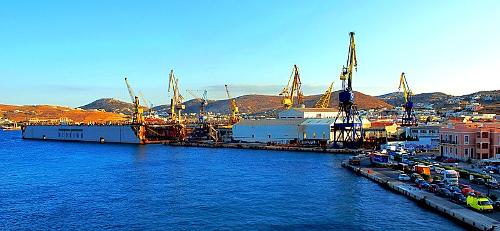 Shipyard GreecePhoto: Nikos Roussos CC 2.0 Generic no changes made
Shipyard GreecePhoto: Nikos Roussos CC 2.0 Generic no changes made
Most of the industry is concentrated around Greece's two largest cities, Athens (36% of all businesses) and Thessaloníki (12.2%). Other industrial centers are Patras and Volos. Approx. 42% of all workers in the industrial sector work in Athens. Small businesses dominate: 85% of all approximately 150,000 companies have fewer than ten employees and the industry is therefore characterized by low productivity. As a result, the investment level is of course also very low.
The main branches of industry are textiles, foodstuffs, tobacco and chemical industries and shipbuilding. The main industrial products are: preserved food, textiles, metal products, household appliances and ships. In addition, there are several large factories for the production of fertilizers, cement, steel and aluminum and of the four petroleum refineries, two are government-owned. There is hardly any heavy industry.
Tourists purchase many items of ancient folk art, such as coarse carpets, decorated with geometric motifs woven or woven into them, headscarves, embroidered linens, pottery, carvings, leather articles and goldsmiths.
Trade
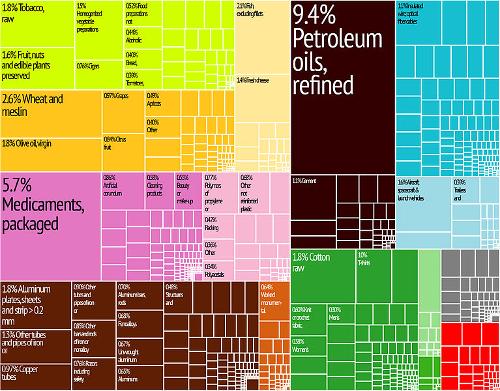 Export GreecePhoto: R. Haussmann, Cesar Hidalgo, et.al CC 3.0 no changes made
Export GreecePhoto: R. Haussmann, Cesar Hidalgo, et.al CC 3.0 no changes made
Many small and large companies and half of all employees involved in trade can be found in Athens again.
The trade balance is in a chronic deficit and was in 2017 (imports $ 52.3 billion, exports $ 31.5 billion). The large trade deficit has exploded since Greece joined the European Union in 1981. Trade borders were then opened and the Greek products had to compete with the high-quality Western European products and the much cheaper products from Eastern Europe and the Far East. Greek imports are still increasing significantly every year. On the other hand, exports, which mainly consist of traditional low-value products, are growing little or not at all.
Foreign debt was $ 506 billion in 2017. In addition to the EU (particularly Germany, Italy, France and the Netherlands), Turkey and Russia occupy a prominent place. Trade with the neighboring Balkan countries and the countries around the Black Sea is increasing every year. It is estimated that more than 15% of Greek exports go to these countries.
The Arab countries remain important because of the petroleum imports. Important import goods are energy, dairy products, beef, machines, cars and trucks, petroleum and luxury goods. Exports are mainly agricultural products, raw materials, clothing, tobacco, cement, semi-processed minerals, footwear and petroleum products.
The main distribution channel in Greece is retail. The retail sector employs approximately 430,000 people and the sector is still largely made up of small family businesses. In the 1990s, this picture began to change under the influence of a number of government measures. Price controls and controls on profit margins were lifted, store opening hours were released and the deployment of part-time staff was made possible by the flexibilisation of the labor market. The result was an increase in scale and the arrival of the first European retail chains. This development has been particularly noticeable within the food sector, as the French New Carrefour (Carrefour / Promodès) and the Belgian Delhaize have now conquered a very large market share. The German Metro with Makro "cash and carry" and the German Lidl are also represented on the Greek food market. German Aldi is also expected to enter the Greek market soon.
Information technology
The Greek IT industry is a relatively young but dynamic economic sector. After the buying wave that accompanied the 'millennium bug', growth has clearly stabilized. Despite these positive developments, expenditure on IT products has been relatively low so far.
This market is dominated for approximately 50 percent by imports from abroad. More than 40 percent of imports come from the EU countries. The main European suppliers of IT products to Greece are Germany, the Netherlands, England, France and Italy. About 55 percent come from the US. Besides the United States, the main other suppliers are Taiwan, Japan, Thailand, China and Singapore.
Aquaculture
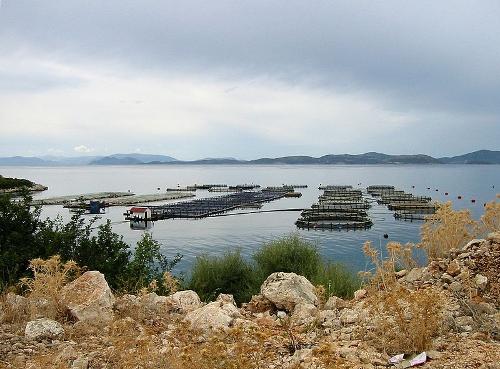 Aquaculture GreecePhoto: AlMare CC 2.5 Generic no changes made
Aquaculture GreecePhoto: AlMare CC 2.5 Generic no changes made
Aquaculture in Greece is a growth sector. Ten years ago, the production of Greek fish farms was virtually nil, but today Greece is leading in this sector in Europe with 50 percent of total European production in 2000.
The sector grows by 10 percent annually. The main exporters from China and Norway who dominate this sector worldwide now recognize the Greek fish farms as the leader in the Mediterranean area.
Greece invests and focuses almost exclusively on the production of sea bass and sea bream. Sub-sectors are trout, carp, eel, mussels, salmon and shrimp.
Traffic
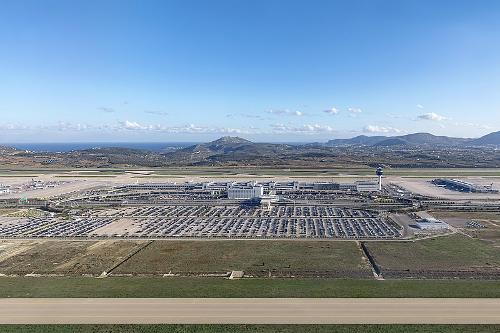 Athens Internatinal Airport, GreecePhoto: Manfred Werner (Tsui) CC 4.0 International no changes made
Athens Internatinal Airport, GreecePhoto: Manfred Werner (Tsui) CC 4.0 International no changes made
Greece has few good and fast motorway connections that meet international standards. In 1999, the length of the road network was 39,500 kilometers, of which only 500 kilometers consisted of motorways. In recent years, serious work has been done on improving the motorway infrastructure. However, the mountainous landscape makes it difficult to significantly improve the existing infrastructure.
A new major north-east-northwest connection, the Egnatía Highway, is being constructed. This highway runs from the northwestern port city of Igoumenitsa via Thessaloniki to Alexandroúpolis on the Turkish border. The Egnatía axis is to connect the Adriatic Sea with the Black Sea. Progress is also being made with the construction of the south-north axis, the so-called PATHE highway, which connects the major cities of Patras, Athens, Thessaloniki and Evzoni on the border with Bulgaria. The Greek government is thus responding to the initiatives of the European Union to develop major European transport links. There are also plans to build a north-south motorway link that will link the west of the country from Igoumenitsa (beginning of Egnatía highway) to Patras (beginning of Pathe highway) in the Peloponesos via a large suspension bridge over the Gulf of Corinth at the towns of Rion and Antirion.
In Attica, many projects are also being initiated under the "Attica SOS" program, some of which also relate to the improvement of the motorway infrastructure. A new 50 km motorway (Spáta-Stavrós-Elefsína) will be built that will link the new Athens airport at Spata with the industrial area of Elefsína. Part of this was put into use in March 2001. A start has also been made in Attica on the construction of the Hymettus ring road. This ring road is of great importance for tackling the traffic problem and air pollution in Greater Athens.
The Greek railway network has a length of 2,503 kilometers (1999).
The inhospitable landscape makes connections more difficult, requiring major investments. The lack of financial resources has led to inadequate rail infrastructure with different rail widths and, for the most part, single-track lines hindering efficient transport. The rail connections between the Greek ports and the Southeastern European hinterland also leave something to be desired.
Great priority is now being given to improving the infrastructure of the main railway lines in order to allow speeds of 200 kilometers per hour. The existing train equipment will also be replaced and work is underway on electrification and double track construction of the Athens-Thessaloniki, Athens-Corinth and Corinth-Patras lines.
Work is also underway on the extension of the network that will connect different suburbs of Attica. First, a 35-kilometer line will be built from the new Athens International Airport near Sparta to the Athenian Railway Center (SKA).
In addition, the Athens metro is being expanded. Inaugurated in 2000, the metro consists of two underground lines of 18 stops in total.
Investments are also being made in improving the transport options for freight by rail. In the medium term, the aim is to connect a number of major ports (Piraeus, Alexandroúpolis, Vólos) and various industrial areas and freight centers (Thessaloniki, Komotiní, Alexandroúpolis, Vólos) to the rail network. The aim of this is to double freight traffic by rail.
The modernization of the entire Greek rail network is estimated to require more than € 4.5 billion. Almost EUR 3 billion of this is funded with EU funds from the third Community Support Program.
Greece's merchant fleet is the largest in the world. In 2000, 3,584 merchant ships were Greek owned, but only 909 of them sailed the Greek flag. The reason for this is a regulation that makes it mandatory that a large percentage of the crew must be Greeks. Greek sailors are considered a relatively expensive labor force. In addition, tax rates were significantly higher until 2001 than in countries with so-called offshore registers. To make the Greek registry more attractive, the government reduced the tax by 50 percent in 2001.
The Greek merchant fleet has traditionally been a very important source of income in the balance of payments.
Greece has 123 ports, but only 27 of them are significant. The major ports of Piraeus near Athens and Thessaloniki in the north are adequately equipped with container facilities. Piraeus is an important cargo transhipment center but lacks a good train connection with the South East European (Balkan) hinterland. The Hellenic Railways Organization OSE is now working to connect this port to the country's rail network. The ports of Vólos and Alexandroupolis are also connected to this. The port of Thessaloniki is outside the route for most ships sailing between Europe and the Far East.
The Greek government plans to privatize the port authorities of Piraeus and Thessaloniki. Another priority is the extension and modernization of the ports of Patras and Igoumenitsa in the west of the country, which serve as important connecting points with Western Europe.
As far as passenger transport is concerned, all domestic ferry services will not be opened to foreign competition until 2004. This late date has to do with the exceptional position that Greece has stipulated from the EU. Until 2004, all routes to the Greek islands will be operated exclusively by Greek ferries. The government recently announced that it would release these routes earlier.
Due to the large number of islands, Greece has many airports: 64 with paved and 16 with unpaved runways. Most of these airports have insufficient facilities and do not meet modern international standards. However, since March 2001, Greece has a new, very modern, international airport at Spáta, southeast of Athens. The new airport, officially called "Elefthérios Venizélos", was to replace the fifty-year-old "Athens Hellenikón".
Other regional airports will also be modernized in the short term. The Greek Ministry of Transport has already planned a series of airport projects. This involves not only the construction of terminals and runways, but also the installation of technical equipment such as the layout of terminals, baggage handling systems, electronic signage and the like.
A concentration process has been observable within the aviation sector since 1999. Greek companies are increasingly merging with each other in order to compete against larger international companies. A recent example is the merger between Aegean and Cronus Airlines.
According to data from Greek research firms, the Greek aviation sector is showing a positive development. The growth is particularly noticeable in the passenger market, while the air freight market shows no growth potential. The best results are achieved in the private sector. As a result, Olympic Airways (OA), the national airline, is losing market share. Olympic Airways has run into serious difficulties since its nationalization in 1975. Despite various restructuring measures, the company is still in financial distress.
Sources
DuBois, J. / Greece
Times Books International
Europese Unie : vijftien landendocumentaties
Europees Platform voor het Nederlandse Onderwijs
Gerrard, M. / Griekenland
Kosmos-Z&K
Koster, D. / Griekenland
ANWB
CIA - World Factbook
BBC - Country Profiles
Copyright: Team The World of Info